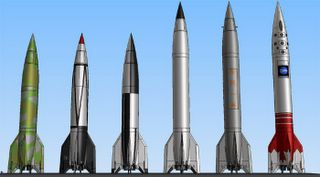Rocket Science - Press Release - Go to Space

Left to right:
1: Germany's V-2 rocket, used from 1943 to 1945
2: USA's V-2, flown from 1946 to 1952 under various configurations. TF-1 shown (1951)
3: Soviet Union's R-1, flown from 1947 to 1953, launched with variations in design.
4: Soviet Union's R-2, was in service from 1953 to 1957.
5: China's DF-1, their version of the R-2, active from 1959 to1963
6: Canadian Arrow, first passenger vehicle version.
According to international agreement, space starts at an altitude of 100km (62 miles). Any flight that takes you to this altitude will let you earn your astronaut wings.
It is possible to make sub-orbital flights that can travel far above the orbit of the ISS and space shuttles, however this type of high altitude sub-orbital flight is usually reserved for scientific experiments only.
PLANETSPACE will take you to sub-orbital space onboard the Canadian Arrow spacecrafts.
The Canadian Arrow design is based on the V-2 rocket used during the early days of spaceflight. This vehicle has been updated using today's technology and data from over 3,000 previous flights of the early V-2 type rockets.
Added to the Arrow design is a state of the art escape system that will pull the crew cabin to safety should a problem with the booster occur during flight or while on the launch pad. Take me there!





0 Comments:
Post a Comment
<< Home